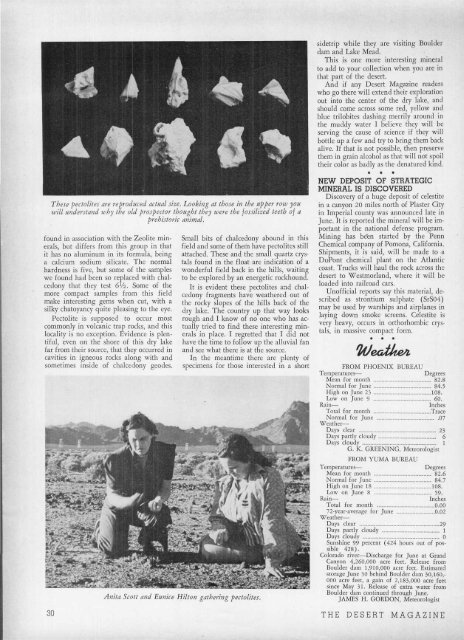THE M A G A Z I N E - Desert Magazine of the Southwest
THE M A G A Z I N E - Desert Magazine of the Southwest
THE M A G A Z I N E - Desert Magazine of the Southwest
Create successful ePaper yourself
Turn your PDF publications into a flip-book with our unique Google optimized e-Paper software.
These pectolites are reproduced actual size. Looking at those in <strong>the</strong> upper row you<br />
will understand why <strong>the</strong> old prospector thought <strong>the</strong>y were <strong>the</strong> fossilized teeth <strong>of</strong> a<br />
prehistoric animal.<br />
found in association with <strong>the</strong> Zeolite minerals,<br />
but differs from this group in that<br />
it has no aluminum in its formula, being<br />
a calcium sodium silicate. The normal<br />
hardness is five, but some <strong>of</strong> <strong>the</strong> samples<br />
we found had been so replaced with chalcedony<br />
that <strong>the</strong>y test 6V2. Some <strong>of</strong> <strong>the</strong><br />
more compact samples from this field<br />
make interesting gems when cut, with a<br />
silky chatoyancy quite pleasing to <strong>the</strong> eye.<br />
Pectolite is supposed to occur most<br />
commonly in volcanic trap rocks, and this<br />
locality is no exception. Evidence is plentiful,<br />
even on <strong>the</strong> shore <strong>of</strong> this dry lake<br />
far from <strong>the</strong>ir source, that <strong>the</strong>y occurred in<br />
cavities in igneous rocks along with and<br />
sometimes inside <strong>of</strong> chalcedony geodes.<br />
30<br />
Small bits <strong>of</strong> chalcedony abound in this<br />
field and some <strong>of</strong> <strong>the</strong>m have pectolites still<br />
attached. These and <strong>the</strong> small quartz crystals<br />
found in <strong>the</strong> float are indication <strong>of</strong> a<br />
wonderful field back in <strong>the</strong> hills, waiting<br />
to be explored by an energetic rockhound.<br />
It is evident <strong>the</strong>se pectolites and chalcedony<br />
fragments have wea<strong>the</strong>red out <strong>of</strong><br />
<strong>the</strong> rocky slopes <strong>of</strong> <strong>the</strong> hills back <strong>of</strong> <strong>the</strong><br />
dry lake. The country up that way looks<br />
rough and I know <strong>of</strong> no one who has actually<br />
tried to find <strong>the</strong>se interesting minerals<br />
in place. I regretted that I did not<br />
have <strong>the</strong> time to follow up <strong>the</strong> alluvial fan<br />
and see what <strong>the</strong>re is at <strong>the</strong> source.<br />
In <strong>the</strong> meantime <strong>the</strong>re are plenty <strong>of</strong><br />
specimens for those interested in a short<br />
Anita Scott and Eunice Hilton ga<strong>the</strong>ring pectolites.<br />
sidetrip while <strong>the</strong>y are visiting Boulder<br />
dam and Lake Mead.<br />
This is one more interesting mineral<br />
to add to your collection when you are in<br />
that part <strong>of</strong> <strong>the</strong> desert.<br />
And if any <strong>Desert</strong> <strong>Magazine</strong> readers<br />
who go <strong>the</strong>re will extend <strong>the</strong>ir exploration<br />
out into <strong>the</strong> center <strong>of</strong> <strong>the</strong> dry lake, and<br />
should come across some red, yellow and<br />
blue trilobites dashing merrily around in<br />
<strong>the</strong> muddy water I believe <strong>the</strong>y will be<br />
serving <strong>the</strong> cause <strong>of</strong> science if <strong>the</strong>y will<br />
bottle up a few and try to bring <strong>the</strong>m back<br />
alive. If that is not possible, <strong>the</strong>n preserve<br />
<strong>the</strong>m in grain alcohol as that will not spoil<br />
<strong>the</strong>ir color as badly as <strong>the</strong> denatured kind.<br />
NEW DEPOSIT OF STRATEGIC<br />
MINERAL IS DISCOVERED<br />
Discovery <strong>of</strong> a huge deposit <strong>of</strong> celestite<br />
in a canyon 20 miles north <strong>of</strong> Plaster City<br />
in Imperial county was announced late in<br />
June. It is reported <strong>the</strong> mineral will be important<br />
in <strong>the</strong> national defense program.<br />
Mining has be"en started by <strong>the</strong> Penn<br />
Chemical company <strong>of</strong> Pomona, California.<br />
Shipments, it is said, will be made to a<br />
DuPont chemical plant on <strong>the</strong> Atlantic<br />
coast. Trucks will haul <strong>the</strong> rock across <strong>the</strong><br />
desert to Westmorland, where it will be<br />
loaded into railroad cars.<br />
Un<strong>of</strong>ficial reports say this material, described<br />
as strontium sulphate (SrS04)<br />
may be used by warships and airplanes in<br />
laying down smoke screens. Celestite is<br />
very heavy, occurs in orthorhombic crystals,<br />
in massive compact form.<br />
• • •<br />
Weatlven,<br />
FROM PHOENIX BUREAU<br />
Temperatures— Degrees<br />
Mean for month 82.8<br />
Normal for June 84.5<br />
High on June 23 108.<br />
Low on June 9 60.<br />
Rain— Inches<br />
Total for month Trace<br />
Normal for June .07<br />
Wea<strong>the</strong>r-<br />
Days clear 23<br />
Days partly cloudy 6<br />
Days cloudy l<br />
G. K. GREENING, Meteorologist<br />
FROM YUMA BUREAU<br />
Temperatures— Degrees<br />
Mean for month 82.6<br />
Normal for June 84.7<br />
High on June 18 108.<br />
Low on June 8 59-<br />
Rain— Inches<br />
Total for month 0.00<br />
72-year-average for June 0.02<br />
Wea<strong>the</strong>r-<br />
Days clear 29<br />
Days partly cloudy 1<br />
Days cloudy 0<br />
Sunshine 99 percent (424 hours out <strong>of</strong> possible<br />
428).<br />
Colorado river—Discharge for June at Grand<br />
Canyon 4,260,000 acre feet. Release from<br />
Boulder dam 1,910,000 acre feet. Estimated<br />
storage June 30 behind Boulder dam 30,160,-<br />
000 acre feet, a gain <strong>of</strong> 2,183,000 acre feet<br />
since May 31. Release <strong>of</strong> extra water from<br />
Boulder dam continued through June.<br />
JAMES H. GORDON, Meteorologist<br />
<strong>THE</strong> DESERT MAGAZINE

















